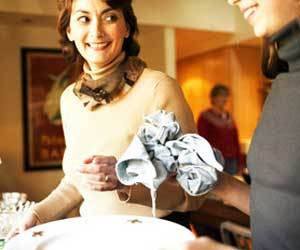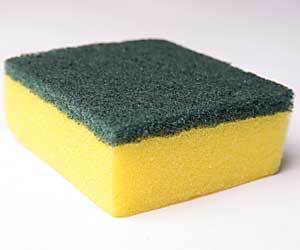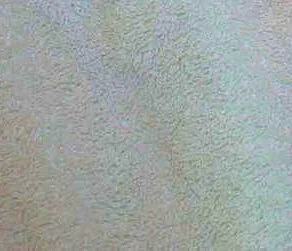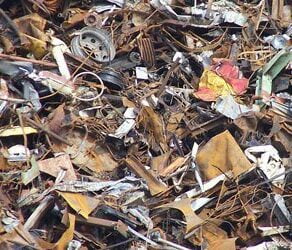Dish  rags are handy for all sorts of cleaning tasks in the kitchen. Unfortunately, with exposure to so many food crumbs, spills and residue, they can quickly develop an odor. Frequent cleanings will help, and following the steps below will ensure they are germ and bacteria free and ready for their next turn at the sink.
rags are handy for all sorts of cleaning tasks in the kitchen. Unfortunately, with exposure to so many food crumbs, spills and residue, they can quickly develop an odor. Frequent cleanings will help, and following the steps below will ensure they are germ and bacteria free and ready for their next turn at the sink.
Boiling Method
You Will Need:
- Large pot
- Water
Steps to Clean the Dish Rags:
- Fill a pot with water.
- Bring it to a boil.
- Add the dirty rags to the boiling water.
- Boil for 15 minutes. The boiling water will kill any mold, mildew, bacteria and germs that may be on the cloths.
- After boiling, wash and dry as normal. The cloths will be sanitized and smell fresh.
Sanitizing with Bleach or Vinegar
You Will Need:
- Bleach OR
- White vinegar
- Laundry detergent
Steps to Clean the Dish Rags:
- Add the soiled dish rags to the washing machine.
- To use vinegar, add ½ – 1 cup of white vinegar, depending on the size of the load, along with your regular laundry detergent. Use hot water to wash.
- For bleach, add ¼ – ½ cup of bleach, again, the amount depends on the size of the load.
- Hot or cold water can be used to wash a load with bleach.
- Do not use both vinegar and bleach. The combination of those two chemicals creates toxic fumes. Also, they both do the same thing, so only one is needed.
- Complete the wash cycle as normal.
Additional Tips and Advice
- If the rags are particularly greasy, use the vinegar method above. Vinegar helps cut through grease.
- To keep rags from developing a smell, rinse them thoroughly and hang to dry after each use.
- Avoid leaving rags balled up or sitting in water for extended periods of time.
- Use a new dish rag each day to keep them fresh. Keep a supply on hand so they can be replaced as needed.
- Thinner dish cloths will dry faster, which can prevent mold. Although thicker rags can be great, they also hold moisture and need to be cleaned more frequently.
- Never use fabric softener on dish rags as it deposits a film on the rags that makes them less absorbent and also should not be used around food. Vinegar is a natural fabric softener, so further softening will not be necessary if using vinegar.









Place the wet dishcloth in the microwave on high for 60 seconds. Be careful when taking the rag out because it will be very hot. Your dishcloth can be used over and over again without having to launder it often because the microwave kills the germs, therefore sterilizing the rag.
When I’m finishing doing dishes, wiping countertops, stove, sink, etc., I put the rag in a dish with warm water and OxiClean. Most of the stains disappear, the OxiClean sterilizes, and the rag smells better. I used to use dish rags only once or at most twice a day. Now, I don’t have to throw them in the laundry so often.
I used to use OxiClean occasionally on my cotton dishcloths to make them fresh and clean. However, I stopped when I noticed that they were becoming lighter in color and developing small holes. Now I use the boiling water method, and also add Mule Team borax to my wash. It always makes my towels smell fresh and I’ve never had a problem with it changing colors or making holes.
I always alternate two cloths or sponges from dishwasher to sink whenever I do a load of dishes (at least once a day). I place the soiled one on the bottom rack by preference. It seems to dry better and the idea of it not dripping soil onto the bottom dishes just makes me feel better.
Between loads, I rinse it out with a little bleach or Oxy Clean. I rarely have that lingering smelly rag scent. And when I do, there’s usually a load of dishes to do, or it’s time to start with a new set of cloths or sponges…
When done washing the dishes, rinse cloth in hot water from the tap, wring out well, then rinse well with cold water, wringing it well again. When your kettle is boiled for any reason, pour the extra boiling water over the cloth. Let it cool and wring it out. The cloth will not smell and will stay quite clean for a long while. Throw it in the washing machine with some bleach if it really needs a good cleaning.
I would like to see a disposable wipe the size of a bath cloth that dispenses like a baby wipe. Once used, it would be thrown in the trash. This would solve the problem of dirt rags hanging around and causing odor and bugs.
Not good for the environment though.
More pollution! Boil your wash cloths or wash. We all survived growing up with our moms using wash cloths! No bleach, no vinegar.
After using, soak dirty rags in a solution of bleach and water (overnight, weekly, whatever works). Rinse well and reuse. Change your bucket/pail of bleach solution weekly.
I boil all my rags in washing soda/OxiClean and Borax. I have a large stainless pail I keep under the sink.
Before throwing the rags in the pail, I rinse the soap out of them. Soap in the rags will cause the whole thing to boil over. When it’s time to wash them, I’ll put 3x as much water in as I have rags, leaving about 4″ of space between the water line and the top of the pail. Add soda and Borax. Cover the pail with foil, and place on the burner, and set the burner to full tilt. Let them boil for half an hour or so, and then I throw them in the laundry.
Gosh Bobbie, no! I used to use disposable wipes every time I cleaned down anything – the kitchen, the bathroom, the bedroom – and I threw out enough bin bags to fill my house three or four times over, just by cleaning alone. (I’d go through one bag in two or three days.) Mad, right?
My new boyfriend is extremely environmentally-conscious and has shown me that by simply sanitizing all my dish rags every week or so, I can keep our little place just as clean with MUCH less waste…and for a hell of a lot less money! 🙂 I reckon that I would’ve used up planet earth (and the contents of my bank balance) single-handedly if I’d kept on the way I used to!
By the way, if you really want to make sure that your dish rags stay fresh between uses, make sure you give them a good scrub whenever you’re finished with them. However, don’t add too much washing up liquid because, as Michael (above) says, the whole thing boils over very quickly!
Is it safe to boil wash dish rags and floor rags together?
Do not boil dish and floor rags together. Solid waste-crumbs, hair, dirt, floor soil-will infiltrate your dish rags and contaminate your dishes. There are different types of dirt and you should not mix the two. You would not wash diapers and dish rags together-an extreme example, but the same principle. You would have to go through each rag and physically remove each piece of solid waste to ensure sanitization-an impossible task since some material works its way into the fabric of the cloth. Reason why I do not eat at people’s houses unless I know them well.
Also, do not dump stuff into the toilet. This, along with the tub, sink, and any drain, is the gateway to our drinking supply. The more filth you dump in, the more Clorox and potential problems occur in our drinking water. Best place to dump is into the ground or throw things in the trash for the landfill. Use the least amount of bleach or whatever to protect the environment. Hydrogen peroxide is one of the most effective and safest disinfectants to use in this situation. Also, hot, hot water and borax are relatively safe environmentally, and effective.
Coco, you will have to change that bleach and water a lot more often then once a week. Bleach becomes ineffective at disinfecting after a short period of time once used. I think within 30 minutes or even less. Also, bleach must be mixed with cool water to properly disinfect so everyone using bleach in hot water is wrong.
My mother boils water and bleach in the pots that she cooks with. She does this to clean the rags she uses in the kitchen. I told her the food tastes like bleach. She talks like she is right and there is nothing wrong. Am I wrong here? I have been reading about this issue and no one says use the same pots you cook with to boil bleach and water to clean your kitchen rags.
For my colored dish rags, I use ammonia instead of bleach. Remember, NEVER MIX BLEACH AND AMMONIA.
My dish cloths always feel greasy. I wash them with “Ultra Tide for cold water powder” and 1/2 cup white vinegar in the wash and another 1/2 cup in the rinse in hot water on the “Colors” setting for 12 minutes. I change them every day and I do not let them sit in water between dish washings.